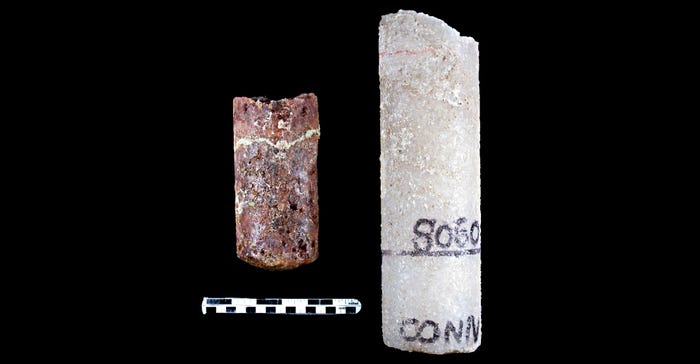
A Michigan company is primed to be the largest domestic source of premium potash for American farmers.
Northeast of Big Rapids, Mich., in the small town of Evart, Michigan Potash and Salt Co. (MPSC) is looking to harvest a rock called the Borgen Bed, which lies a mile and a half below the surface, for potash — a potassium-rich mineral and critical crop nutrient.
Michigan potash is the purest known on Earth today, according to a report by the U.S. Geological Survey.
Covering 15,000 acres, the bed spans over Osceola and Mecosta counties. Company officials say it has the potential to reduce imports of potash, improve the nation’s trade balance, create jobs and improve food security, greatly increase the state’s tax base, improve the rural economy, and provide farmers with an easily accessible American-made product.
It’s been several years in the making, but the company plans to finish its financial campaign of just shy of $1 billion and break ground this fall. But first, MPSC wants to share its story with the community, politicians and other interested parties by hosting a community picnic at the Evart fairgrounds in August or September. The event will include fun activities, as well as educational stations where attendees can learn about everything from geology and the extraction process to marketing and facility construction and more.
“We want to be as transparent as possible and answer all questions,” says Aric Glasser, MPSC chief sustainability officer. “We have been laser-focused on getting the capital raised to build this facility in Osceola County, and we want to put our arms around stakeholders and have everyone walk with us to the finish line.”
The company has already leased mineral rights from 450 families, who will receive royalties, and all permitting is complete. “We're completely shovel ready; we just need to complete funding,” says Jeff Kummer, MPSC chief operating officer.
Construction is expected to take 36 months and employ 300 union workers. Once online, planned for 2024, the plant will offer 150 full-time jobs and will initially produce upward of 650,000 tons of potash and 1 million tons of food-grade salt annually.
“We're going to be investing a billion dollars into a small town, and it should be impactful, maybe transformational, in a number of ways,” Glasser says. “Our initial 300 skilled workers will need places to stay, food and other supplies and services, and thereafter, we’ll have 150 full-time jobs. It’s going to touch a lot of people, families and local businesses.”
Domestically sourced
MPSC says it can supply all of Michigan with its 300,000 tons of annual potash consumption, and it will have easy access to markets in Indiana, Illinois, Ohio and states out East. It can also potentially ship across Lake Michigan to serve Wisconsin.
“We can supply about 10% of the U.S. demand for potash,” Kummer says. “And it just so happens the resource is within a truck’s travel distance of half the potash used to grow our country's food and the world's food.”
Soybean, corn, sugarbeet and potato farmers are some of the largest potash-dependent growers. Currently, 96% of the American farmers’ muriate of potash needs are imported from primarily Canada, Russia and Belarus, says Ward Forquer, vice president of MPSC potash marketing and governmental affairs.
Old potash mines in New Mexico and Utah are about depleted, and only 3% to 4% of the U.S. potash demand is produced domestically, he adds.
“This product is born in the USA, reducing our dependence on imported potash, and despite what might happen in the world, we'll provide the supply right here on our doorstep,” Forquer explains. “So, we don't have to worry about government sanctions and railroad strikes and vessel shortages and other supply disruptions.”
Supply concerns are hitting home recently as the European Union is aiming to hit Belarus with a new round of sanctions by June over the forced landing of Ryanair flight FR4978 and the arrest of a journalist. Potash, Belarus’ major export that supplies a large share of European demand, is reported to be a target for those sanctions, which could affect global markets, Forquer says.
“What is going on in Belarus can make us vulnerable to not having enough potash to satisfy our needs,” Forquer says, while noting the price of potash has nearly doubled in a year. “It just helps solidify the importance of Michigan potash for not only Michigan growers, but to the U.S. grower as well.”
To add another layer of supply concern, Mosaic Co. announced June 4 that it has immediately cut production at its largest conventional potash mine — K1 and K2, at Esterhazy, Saskatchewan — because of flood risks.
The company had planned to close the mines in about nine months due to persistent flooding, but accelerated the closure after water inflow exceeded the company’s pumping capacity. The company is building a new shaft, K3, as a replacement, but it is not expected to be online until 2022, according to Mosaic.
In the meantime, the company plans to restart its idled Colonsay, Saskatchewan, mine. In contrast, the Michigan Borgen Bed is not susceptible to flooding, and MPSC methods of production do not require people underground.
“It’s our responsibility to develop this resource wisely and in a way that moves Michigan forward,” says Theodore Pagano, founder and CEO of MPSC. “Potash is essential for food security, and is a natural and critical crop nutrient.”
The process
MPSC has permitted new potash wells, which will be drilled straight and then directionally from a central location on 2.5 surface acres to cover more than 250 acres of deep subsurface deposits, Kummer says.
Hot water is circulated through deep geothermal wells in the Borgen Bed, creating water enriched in potash and salt. It is then pumped to the facility where the enriched water is boiled. The water is recaptured and recycled back through the system to re-enrich.
The closed-loop system allows for about 90% of process water to be recycled. When water is boiled, potash and salt crystals are formed, which are harvested, cooled, compacted and crushed to size and stored.
Michigan is uniquely set to service its customers with multiple rail lines, as well as by truck, barge, lakers and ocean-going vessels.
Not new
The potash reserve is not a new discovery, as it was discovered during exploration in the early 1980s.
“Having a strong deposit is nice, but you have to be able to access it in a way that protects land, life and resources,” Pagano says. “Otherwise, it’s not worth having.”
Solution-extraction technology was brought to the state in the late 1980s by the Pittsburg Plate Glass’ kalium team, based out of Canada. The kalium team was responsible for the invention and success of the solution-extraction technology in Canada and recognized the promise and strategic location of Michigan.
The team successfully explored, produced and proved its hypothesis by building and operating a facility in Hersey, near Evart. Over time, the kalium team and the Hersey facility were merged into the Mosaic company. Mosaic operated the potash mine until it sold the operation to Cargill Inc. in 2014, when Cargill ceased the facility’s potash production in favor of mining salt.
So, why was a mine with a 150-year resource life closed?
Forquer says even though it was expanded in 1997 to produce 500,000 tons annually, it was small asset in a huge Mosaic portfolio, with Canadian mines producing millions of tons each annually, and the vision for the Michigan mine was lost — at least until now.
About the Author(s)
You May Also Like






